The Mini-Moke Revisited
This page was kindly created by ~jtaylor/"John Taylor, for the Club Mini France.
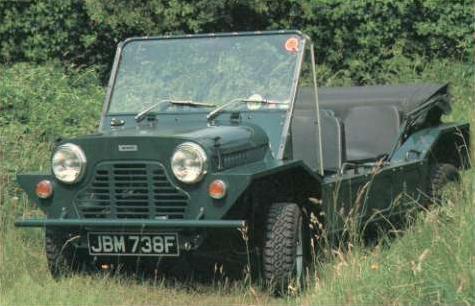
BRTB
Pre-Production/Prototype Mokes:
The Moke was initally developed during the '50s to meet a need in the British Army, and went through a number of different prototypes, including a twin-engined 4WD "Twinni-Moke". The British Army didn't like the Moke much and decided to use Citroen 2CV pickups instead, but some Mokes did end up in military service. Mokes were also trialed by the U.S. Army and several Commonwealth nations including Australia and New Zealand. These early vehicles differ from the later production models, having features like hinged windscreens, different body-shells, wheel-bases, etc.
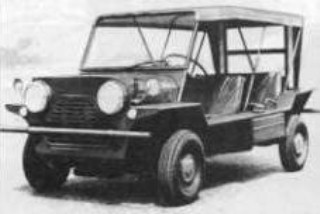
BMTB
One of the early Moke prototypes of around 1960-61. This one appears destined for the United States (note that it's left-hand drive) or possibly North Africa (?). The sides show the original open "buckboard" design, but it has a side-mounted fuel tank like the production models. The front- and rear-end styling is very similar to the production Mokes apart from the large cut-aways on the bottom corners.
"Little-wheeler" Mini-Mokes:
The Moke went into civilian production in 1964 and was available as either an Austin or Morris, depending on the dealer. It was produced for only 4 years and 14,518 were built, only about 10% of which stayed in England. It was extremely basic having a seat for the driver, one wiper blade and little else. Front and rear passenger seats, heater, side screens, sump-guard, etc. were all additional cost extras! Spruce Green was the only colour available, and they were fitted with 10" wheels and the 848cc engine as per the Mini. Production was transferred in its entirety to Australia in 1968, although it was already in production there since 1966. The early Australian Mokes were fitted with a larger 998cc engine, and remained unchanged until 1969.
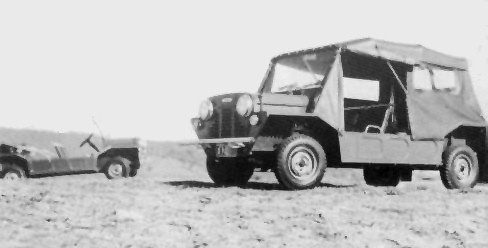
MSS
The little-wheeler Mini-Mokes suffered from poor ground clearance due to the 10" wheels, but were still agile performers. The side boxes house the battery and fuel tank and provide some storage space.
Australian Mokes
The Moke started production in Australia in 1966, when the first civilian "little wheelers" were released. Many changes were made to the original design, including the fitting of larger engines (998, 1100 and eventually the 1275cc), stronger sump guard, parcel shelves, better seats and hood, re-routing of cabling and brake/fuel pipes for greater protection, etc. In an attempt to overcome the Moke's ground clearance problems, 13" wheels were fitted which required special rear trailing arms and wheel arch extensions to cope with the larger wheels. The up-market "Californian" version of the Moke was produced to cater for the growing recreation market. It featured bull/kangaroo bars front and rear, wider spoked wheels, better seats, and rubber floor linings. A utility/pick-up version of the Moke was also produced. Production of the Australian Mokes stopped in 1982 (the assembly lines were used to build more profitable Peugeots!)
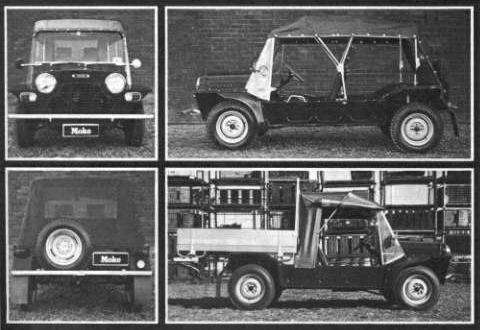
BRTB
The Australian "standard" and utility/pick-up versions of the Moke. The ones shown appear to be early-mid 70's models, having clip-on sidescreens and tubular steel seats with separate headrests.
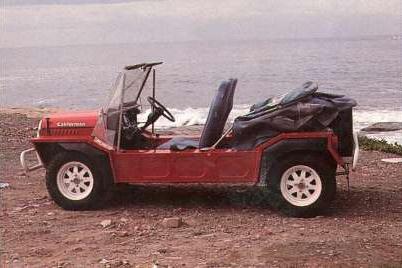
The up-market Californian Moke originally featured a floral/paisley hood, but the later version had blue "demin" seats and hood. Spoked wheels, 'roo bars and interior upgrades improved the Moke's looks, but it could never be called luxurious!
Portuguese and Cagiva Mokes
Two years after the Moke stopped production in Australia, British Leyland Portugal Automoveis started building the "Californian" Moke. This initial run was short-lived due to serious production difficulties. Jim Lambert was sent in by Austin Rover to sort things out, and through his efforts the 1986 Moke was born. This Moke shared many standard Mini parts which cut the costs and allowed the return of the original flat-backed styling as seen on the English ("little-wheeler") Mokes. It was fitted with a 998cc A+ engine and 12" wheels, and the hood and interior trim were excellent. Portuguese Moke production stopped in 1989 after which the Italian company Cagiva produced it for a while. The Cagiva Moke was like the Portuguese Moke, but had the radiator mounted at the front of the engine bay, instead of at the side like the Mini and earlier Mokes. It had some other minor improvements too, such as a hinged, locking battery box cover.
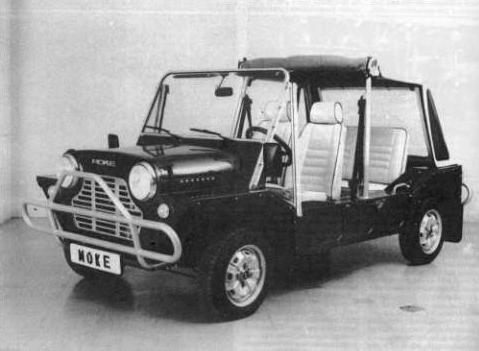
BRTB
The Portuguese production Moke. A roll-cage was fitted as standard, providing the mounting for the retractable lap-sash seat-belts and a clever means of supporting the hood. It shows many similarities with the Australian "Californian" Moke (eg. the front and rear bull bars) and some with the early "little-wheeler" Moke (eg. the original flat back design of the rear wheel-arches).
The photos on this page came from two sources:
| BRTB |
| Mini Moke 1964-1989 - Brookland Road Test Books (ISBN: 1 870642 945). This contains an excellent compilation of Moke articles covering the earliest prototypes through to the Portuguese produced Mokes. It's a pity that it only contains black-and-white photographs, but it is a must-have for Moke enthusiasts! |
| MSS |
| Mini Minor Downunder Including Mini-Cooper and Moke - Marque Spotlight Series #1 (ISBN: 0 947079 10 6). This book deals with the Australian produced Minis and Mokes, mainly concentrating on the Mini. Most of the photographs are black-and-white, but there are some colour plates too, and includes some great racing photos, and Mini/Moke kit and prototype cars. Worth checking out if you can find a copy. |
Production Time Line Info
Time Line on Australian Mokes
Time Line on English Mokes